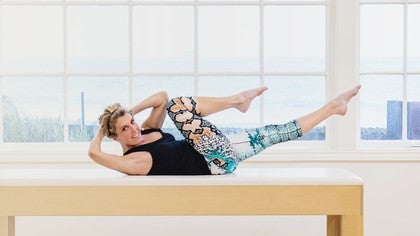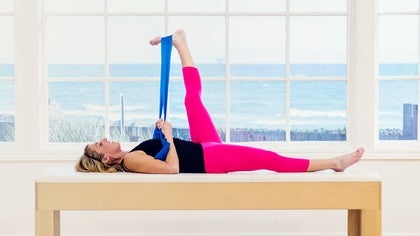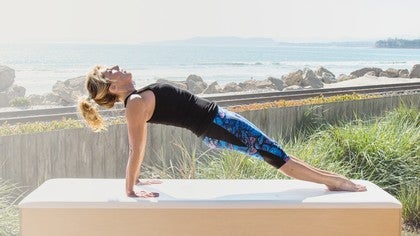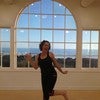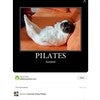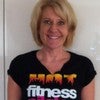Description
About This Video
Transcript
Read Full Transcript
Welcome to day five. Are you halfway through the challenge or are you 15 seconds beyond halfway you choose? It's up to you. Joseph [inaudible] famously is quoted for saying, if your spine is inflexibly stiff at 30 you're old. If your spine is flexible at 60 you're young. So today I'm calling Selphyl spine day.
We're going to explore where we are, where we've been, where we need to be, what the differences are, and c and that's it. And hopefully feel a lot better at the end. So let's go to a wall. Let's just walk on over to a wall and we'll just sort of take note. That's all it is. Come stand as close as you can and recognize that everybody's body, everybody's flexibility, everybody is different. So you're, we're going to need to adjust for you and I'm going to give you what you're looking for.
And really all we're trying to do here is find out where we are today and, and the wall helps. It's a tactile sense of something. So I'm, I'm going to step away cause I need to, you might not. And again, depending on your proportions, depending on lots of things. So take it so you feel that the sacrum's are that the most bony part in the, not the bum, but just above it, right? Not your low back either. And let that be the first contact point where you can be there, where it feels like your sits bones are just hanging heavy, your tailbone is just hanging heavy. The rest of you now from me, it's already, notice if I'm leaning into it, I'm leaning away from the wall actually. So I, I know I'm going to have to work to touch it, particularly the back of my head and we'll deal with the shoulders in the second. So, so there you are. You've got the sacred and touching the wall. Find your shoulder blades on the wall. Don't worry about the low back. It's probably a way if most spines are away depending, right?
So don't worry about that yet. Maybe find the back of the arms and the back of the shoulders and then notice in later I'm saying, just notice. That's my face from me. Notice are you thrusting the ribcage forward? Do you have tension in your low back? Do you feel tension in your neck?
These are things we have to learn about ourselves. How do we adjust for ourselves? So what I'm going to suggest is keep the sacrum the lowest part of your spine where it is. If you are really struggling here, move your feet away. You can bend your knees, but you'll be working harder in other places. So use this little muscle as you have two. From there I'm going to encourage us all to try to press our spines into the wall. I'm going to move my arm.
I'm just folding my arms so that if we have a side view for for you, you can see that too. You don't have to do that. You can maybe put them out. So if you have a mirror, you look,
I'm going to hang my arms now so that you can come with me before just dropping our head forward and that's a point that matters when we go to do our ab work. And this all translates to when we're on the floor, right? We're vertical now, so it seems easy and maybe not so sensical, but you're upright. But this is the same position you are when you're on the floor. You lengthen through the neck as if your head's climbing up the wall first. You're still trying to get those bones on the wall. Let's make that the goal.
Let your head come forward. I never did touch my neck. That's all right. That's not really how the spine is shaped, but I am trying to press my shoulder blades. I am now trying to press the lower rib cage. I am trying now and thank goodness successfully touching my lumbar spine, my low back, and then I come down to around the tail bone and I've come away from the wall. Okay, before we do anything else, just notice where are your shoulders?
Are they dropped off the collarbones? You hear a lot of PyLadies teachers say keep your collarbones wide or stay broad through the chest or stay in the box. These are just terms for, don't be lazy. Keep your shoulders on your back. It's another way you'll hear it. So the difference is if you're looking is that you're not just hanging on yourself. Support Yourself, and part of that's coming, not part of it. Almost all of it is coming from the front of your body.
So you pull the belly in, you support yourself. I don't have to tell you how to do that. You know how to do that. Support yourself from the front. Don't worry about your legs. I'm going back up. But I'm going to find every bone this time and I am not going to let my shoulders hang off my back. I'm going to find the low back. That is not easy for me and yes, I had to Tuck more. Right?
You hear that too? I'm tucking, but I'm going to find that spot. I'm going to hit that bone and oh, interesting. It's kind of off to one side, so I'm going to fix it. I'm going to feel where I am today and I'm going to keep going and I will not say that so slow next time, but investigate yourself. Let's go back the shoulders on, head on back of the head, touching as best you can. Not everyone's going to get there. Trust me. You sit at a computer and I do. It's not easy.
Let's go crawl up the wall theoretically with your bones that, oh wow. Did you see that? I already got away from myself. Let yourself slide your head on the wall. If it was there to begin with, if not, aim for it later. Round over. Now here, find that path, that same path. Find the bonds. Push your bones into the wall. I don't mean hurt yourself. I don't mean strain. I just mean, how would you, if you could, I don't need to tell you. Go to the point where the low back is off. I'm about at my tailbone. I feel kind of flat and like, who cares? So I'm going to curl back up, but I'm going to try. It's easier for me coming back up.
I just picked up my shoulders again. Find the low back and somewhere around here from me, and this is for a lot of people, I believe in my experience that we get to stuck place in the low back. So if you can really find it here on the wall, you'll know what to look for on the floor or when you don't have
Sometimes that's all that matters up and go down. It feels a little weird. I'd go,
It's just an investigation.
Try It away from the wall and then we'll get on the floor and do plots. Okay, so let's investigate a little more. I've come away from the wall you're mad is nearby cause we're going right down to it. Stand with your feet. Sitz bones, distance apart, straight off your hips, whatever you feel that is. Think the inner side rather than the outer side and be nice. Here we go. We're standing tall. You can feel that wall, right? Oh, that means I have to adjust cause I know what that felt like. That pressure, that tactile awareness becomes important throughout this whole practice, throughout life. Really. Then I feel, oh my rib cage. If, if this was the wall, I have to pull the ribcage back. My neck has to get longer. Let's go. Inhale, grow taller. Before you go over, support yourself
Find the imaginary wall that is now overhead in here. Exhale, roll back up. It doesn't matter if you go all the way to the floor, you can play with that. You can play in general.
I wore my snake pants on. Purpose. I'm going to find a way to slither through the next few minutes. Sit down however you need to sit tall, holding on behind your legs. I have my feet a little bit apart and I'm making it easy. Slither movement of the spine. Flexibility.
I'm going to start with my feet flex cause it's way easier for me or holding onto the back of the legs. Knees are pointed up. My spine is long as if there were a wall, but then it changes. I exhale and I roll back. I'm actually Kinda digging my heels into the ground. As I roll back, I'm finding that imaginary wall or in fact the mat. I'm holding. No lie. I'm helping myself. Inhale, start the exhale. Push further into the mat. Come forward.
Don't worry about your head. Keep your eyes sort of in a position that allows you to stay in shape and lengthen up. I'm inhaling. If you care, what I care about is that you read, exhale, roll back. I find that an easy way to kind of get into this because it's going to get harder. I know you don't think so. Inhale, exhale, press the valley back and the exhale allows for the compression to come forward. Use your arms as much or as little as you want. I'm actually pushing down on my legs to sit taller here.
If you feel easy with your feet and it doesn't strain you anywhere else that inhibits your abdominals or spine, put them on the mat. What about those shoulders that way up here again, know their down. Inhale. Exhale, hold that low back on the mat as long as you can. Just like you did the wall. Sit up tall. Inhale, exhale down. You can keep this going. I'm going to pause us here.
Inhale. Nothing has to change because if your spine is flexible, you can hold the shape and you lift your right arm up on an inhale. Oh, you can take it away back. If you're flexible in your spine and your arm, but your body shape doesn't change, exhale, bring it down. Let's do the other arm inhaler.
Xcel down here, your own boss on these five through 10. Roll down. Find the bones. Find the bones. Oh, I had to tuck more. What about you? A bronze widy nail, right arm up or one arm. Exhale, put it down. Don't change the shape of the spine. Can you hold it? Can you be flexible and strong? Of course you can. You might have to work at it.
Inhale, hold. Hold on. Literally do your legs. Don't be afraid to use the help that you have in your body to bring you forward, but only use what you need so you have more for later. Inhale, exhale down. Make it easy. That's your cue. When arm goes up on an inhale, shape change except
Do you still feel the bones of your low back and heal the other arm up? Exhale down here. How about both arms or just hold on and take another breath? Inhale, do not lean back to not lean back. Act like you're getting up off the mat. Exhale, arms go forward. Grab on or not. I'm grabbing on. Exhale. Deepen the curve.
Deepen the flexibility. Deepen the bend of your spine. Hold on somewhere that helps
Try not to lean back here. The hand that's in back goes to the front legs or the opposite arm goes to the front leg. Use it not to pull, but to push down and lift and twist further. Try not to lift the leg a lot. We're going for the rotation from here without unwinding. Pick the hand back up and come back to center. Other way.
Inhale to the front or to the back. You see that nice and long bar can goes to their forward like lift all twist further. If you can, there's some assistance but it's not a gigantic Yank and goes back and return and inhale, rotate alternating sides. Exhale, grab that opposite handled leg. Use it to push and lift you as you rotate further. There's bend ability flexibility that way too. Try not to snap out of it. Return the hand and come back and already you feel that spinal column.
Inhale the other way. XL hand comes down. Grow Taller, checking. See is your chin reaching up to the sky? Try not to let it return the hand and come back to center and rotate. Opposite way each time, trying for a little more space, a little more pliability. Exhale. Inhale. Return your hand and exhale centered.
Just one more time in here. Hand comes down. Let yourself twist a little further, a little taller. Minimize how much you use that arm. Then return it behind your head. Come back to the center and release,
So far, so good. Arms are down. Inhale, exhale. Just like you're on the wall. Feel the back of the shoulders. Roll yourself up. Feel your feet. Stand into yourself so that when you're at the top, hopefully feel a straight line across the hips. You feel the back of the shoulders on the mat and you can actually see towards your knees. In other words, the ribs aren't higher or you want, you don't want that back pressure. Let the back of the legs work. Exhale, roll down bone by bone. Find the walls, right.
That's not what I want to say. Find the ease
Just a chest and to
The knees are totally line up. Exhale back to center. The same action. Go on the other way. Now inhale, keep the back of the arms down. Mine look like they're off the ground cause I am off the ground, but you might not be exhale now. Make It successful. That's the goal. You're your rules, if you will, and to keep the knees and legs together as if they're one, and then from there sequentially, bring yourself back to the middle. Inhale to the opposite direction. Then find the back of the rib bones.
Find the back of the pelvis and the knees have just naturally ended up there again.
Press your knees and your hands and pick your head up. When you do, maybe think about that wall that you've, you've not just lifted it, but you'd be long gating through the spine. From here, we're going to extend the legs. Here's your goal. You're going to keep the low back on the mat. You want to be curled up high enough that it is down from there. You're going to inhale, reach the arms and legs forward. If when you do that, your back comes up. You, you lowered your legs too much, right? You might want to be here and then fold back in. Do it again in here.
Pull it back in. And when you do, press deeper into the mat or the so-called wall. Inhale, reach forward. Exhale, scoop the belly. Hold and pull the knees in and you can pull them in really close and lift your butt. But that kind of releases everything, doesn't it? You can also push the knees into your hands and create some resistance. Opposition. Inhale, reach forward. Exhale, do cover more. Feel the back on the mat. Inhale forward. Exhale, pull back. Inhale forward.
Exhale, pull back. Next time, check it out. We're going to stay forward. Is your back still on the mat? If it's not raised, the legs from there, lift the arms up to keep your back on the mat. Bring them back down and hug the knees. Do One more like that. Everything forward first. Inhale, forward reach. Keep your back down. Raise the arms in minute. You feel a pressure change? You bring the arms back.
Exhale, bring it in. Rest your head.
You let go change again. That's all it is. No pressure changes. You've gotta be strong to hold this flexible position. If your back moves, you got to shorten the lever or go higher. Meaning the leg, right? Let's go a little quicker now. Play four, four, three, three. You can squeeze it all the way in and it and both knees in.
Rest your heads down. Voila. Same exact exercise, but let's get into it first. Push your knees into your hands. You're going to lift up. You know that now, but elongate through the back of the neck as if you are on that wall. Hands behind your head. Leysin fully together. Extend the leg closest to the screen or do the front.
Pull the other one in as much as you can, but also curl up towards it. Rotate towards it, and now switch. We go switch and switch. You can breathe however you want. I am doing a little exhale each time I pass on this round.
Typically we tend to give up at the bottom right. We let everything collapse and then we yank ourselves out of it. Ain't that the truth? Let's just stay stable. Let's stay rolling. So I have a little tuck of my pelvis. We've been calling it. I have a tilt of my pelvis. I'm looking for it.
I'm breathing. It took me a long time to figure it out, so don't worry about it if you're not smooth. Next one, you come up, you stay up. It's essentially rolling like a Bollard and one of my favorites, again, it took me a long time. So let's play with that idea. Bring the in closer. When you're totally upright, it just feels wrong to pick your legs up, doesn't it? So let's get just behind it, but not because we just collapsed behind it because we did what we did on the wall. So we drew the abdominals and we thought about pushing the abdominals backward. I don't know if he thought about it, but he thought about pushing the bones backwards. He picked up one leg.
Are you going to pick up the other? Like bring it close and see if you can just hold the physician. I am just behind my tailbone. It's no secret. Not perfectly afraid. The only reason I'm back here is cause I have to be. The only reason I'm not falling is because I'm working. How's that?
And then there's this weird thing that happens in the middle and that just takes time. Extend your right leg to the extent that you can. It does not have to be straight. If it can do it, bring it back. It's just playing with balance here. Other one, how you want. Can you do both? I can't look at you and do it. All right now let's just hold on underneath.
Make sure there's nothing behind you that you're worried about. Like falling out. Hold underneath your calves, your ankles. Leave them bent. Or if you can go straight, go straight. You're going to roll back. Not because you touched your head, but because the pelvis rolls you back. Here we go. Flexible spine, cervical spine, you come back up and you stop because you,
So we're going to do now is a little bit of back extension going the other way, a little bit of side work. When we're done, that's it. So turn over and come down to what I would call a low swan. This, this will get higher, but for now or low sphinx position, but basically put one hand over the other. Your feet are close to each other. That's all I need to say and bring your hands as if you're dragging everything forward or the mat underneath you. The floor underneath you as you extend your chest forward, like your had a light on your chest and you're trying to point it forward, the ribs are on the floor for now. From that place, maybe look out in front of your hands just a little bit.
Leave your ribs on the floor. If that hurts your back, notice it. Secondly, press the front of your hips into the ground. I don't know how you do it. You do tho or elongating or you feel the front of your legs on the mat or you reach them. I could say to a hundred different ways, but you know best, do not let it hurt your back from there or go lower. Hit all the way down. Lift the right leg up. It's absolutely straight.
It's being pulled by somebody else but not messing up with your spine and you're going to kick it into your glutes twice. Kick, kick, straighten it out. Same like dude. Again, kick, kick, straighten it out. If you can think about it and flex it, do it kick. Then point out same like kick, kick straight in. One more time and kick, kick straight and reach it. Reach it, reach it. Can you still live through the heart still? If the leg, you can even use the lower leg for support. Push down and change.
Here we go. Kick, kick, straighten, kick, kick straight and soften to the shoulders. Lots to think about here, but really don't just think proud, think long. Think I'm working in the back of my legs and a non bouncing around. One more time. Flexing you're pointing is fine with the foot and down we go from there. Put your head down so that you're facing screen.
Take your hands behind you best you can. Grab a couple of fingers. I was taught to lace them fully together. I still like that a lot. Take them up as high as you can on your back. That's not accessible to everyone. I'm totally aware of that. What you don't want is to have your button up in the air and space between the front of the hips and the Mat. If that's happening, focus more on getting the hips down and you can even leave the arms down because that's actually where they're gonna end up in a minute.
So from here you pick a both legs. You're going to kick twice. One, two, stretch them out, extend your arms, palms down, some to the side for now. Bring it back. Turn your head the other way. At least to finger kick, kick, stretch and extend. He'd looked down like on on, I know long like you're on the wall, maybe a little bit arched into the wall. End Kick, kick, elbows down. That's the hardest part, isn't it? And stretch. I let go. The arms, palms down or to the sides of your legs and kick. Kick this time.
Just stay here in this long sort of dark like position. If you feel a lot in your low back, what would you do to feel longer? I'm going to lower my legs a little. They're still off the ground or at least my feet are not my thighs. Turns out I'm going to put my belly in more. I'm going to press the center, the lowest part of my chest down cause I still have to keep the ribs down.
I'm going to slightly look forward
Wishing my mouth was a little wider and then we decide bend. We've done a lot of rotation. We didn't do a lot of lateral flection, but that's okay.
You can drop your legs if you're on something high like I am. Find your way to something where you feel supported by the ground. Cause that's our next lesson. Feeling grounded.
Spring To Life: with Kristi Cooper
Comments
You need to be a subscriber to post a comment.
Please Log In or Create an Account to start your free trial.
